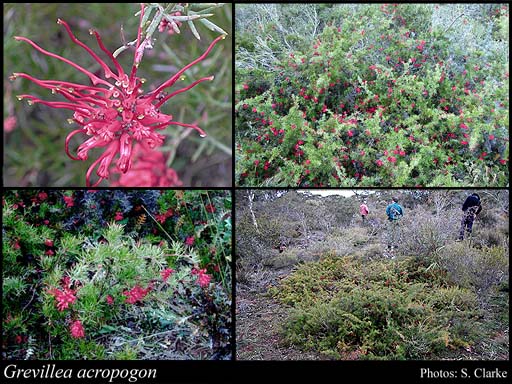- Reference
- Fl.Australia 17A:496 (2000)
- Conservation Code
-
Threatened
A taxon name retains its ‘Threatened’ status until a new name has been officially endorsed and appears in the Gazettal Notice.
- Naturalised Status
- Native to Western Australia
- Name Status
- Current
Prostrate to erect shrub, to 1.8 m high. Fl. red, Jun to Sep. Shallow soil, ironstone. Margins of seasonally inundated areas.

Scientific Description
Shrubs, 1-1.5 m high; branchlets hairy, not glaucous. Leaves alternate, 15-30 mm long, hairy, on the adaxial or abaxial surface, the hairs straight; lamina flat, twice or more divided, tripartitely divided, divided to the midrib; lobes 8-15 mm long, 0.8-1 mm wide, the margins revolute, enclosing the lower surface of the leaf blade, forming a groove either side of the midvein. Inflorescences terminal, red; pedicels 2-2.5 mm long. Perianth 10-11 mm long; tepals all free after flower opens, glabrous; ovary glabrous, stipitate, the stipe 3-4 mm long; pistil 18-20 mm long, red, pollen presenter oblique, style glabrous. Follicles glabrous, not viscid, dehiscent, 10-15 mm long. Flowers in July, August or September. Occurs in the South-west (SW) Botanical Province(s), in the Jarrah Forest (JF) IBRA subregion(s). : Conservation code Threatened (T).
Distribution
- IBRA Regions
- Jarrah Forest.
- IBRA Subregions
- Southern Jarrah Forest.
- Local Government Areas (LGAs)
- Cranbrook.